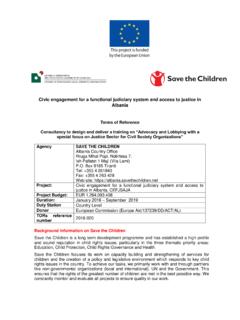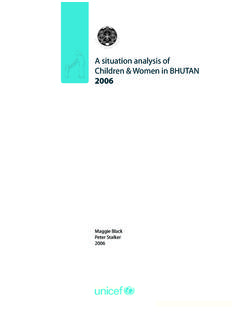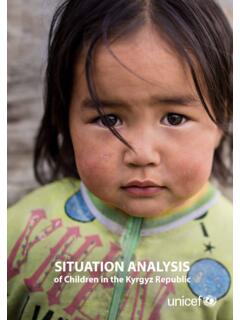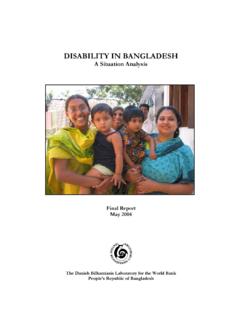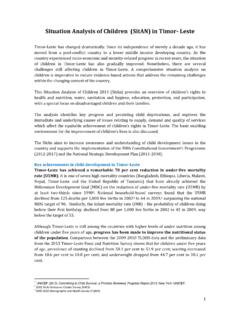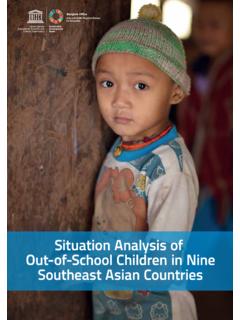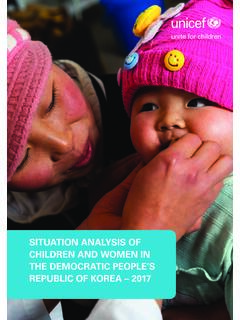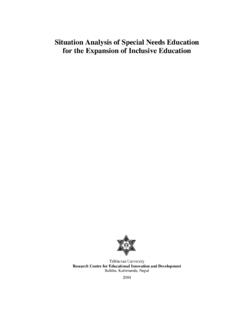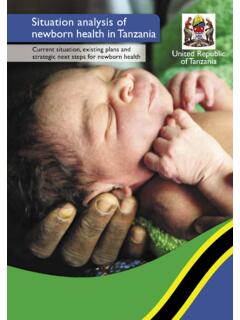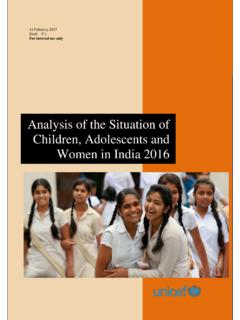Transcription of Child Rights Situation Analysis Albania - Save the Children
1 P a g e 1 Child Rights Situation AnalysisAlbaniaTiranaJuly 20122 P a g e Save the Children sht nj organizat udh heq se e pavarur p r f mij t n bot . Ne punojm n 120 vende. Ne shp tojm jet f mij sh; ne luftojm p r t drejtat e tyre; ne i ndihmojm ata t p rmbushin potencialin e tyre. Ne punojm s bashku me partner t tan , p r t frym zuar p rparime n m nyr n se si bota i trajton f mij t, p r t arritur ndryshimin e menj hersh m dhe t q ndruesh m n jet n e tyre. 2012 Save the ChildrenT gjitha t drejtat t rezervuara. P rmbajtja e k tij botimi mund t p rdoret apo kopjohet lirisht prej p rdoruesve, por jo p r q llime itimprur se, me kusht q do riprodhim i till t shoq rohet me njohjen e Save the Children si , 2012P a g e 1 Child Rights Situation AnalysisAlbaniaTiranaJuly 20122 P a g eP a g e 3 Table of Contents:Map of Albania ..4 List of Acronyms ..5 List of Tables and Figures ..8 Executive Summary.
2 9 Chapter 1: Introduction ..11 Chapter 2: Country Context ..14 Chapter 3: Right to Education ..25 Chapter 4: Right to Protection ..36 Chapter 5: Right to Health ..49 Chapter 6: Right to Participation ..56 Chapter 7: Disaster Risk Conclusions and Recommendations ..67 Appendices:Appendix A: List of Organizations and Work ..71 Appendix B: Tools for Focus Group Discussions and Interview Templates ..814 P a g eMap of Albania :Figure 1: Map of AlbaniaP a g e 5 List of Acronyms:Albanian American Development Foundation AADFA lbanian Children s Alliance ACAA lbanian Demographic and Health Survey ADHSA lbanian Foundation for Conlict Resolution AFCRA lbanian Leke ALLA lbanian Red Cross ARCA ntenatal Care ANCA ustrian Development Agency ADABank of Albania BoAChild Labor Monitoring System CLMSC hild Led Group CLGC hild Protection Initiative CPIC hild Protection Unit CPUC hild Rights Situation Analysis CRSAC hild Rights Units CRUC hildren with Disabilities CWDC hildren without Appropriate Care CWACC hildren s Government CGChildren s Human Rights Center of Albania CRCAC ommittee of Nationwide Reconciliation CNRC onvention on the Elimination of All Forms of Discrimination against Women CEDAWC onvention on the Rights of the Child CRCC orruption Perception Index CPIC ountry Annual Plan CAPC ountry Ofice COCountry Strategy Plan CSPD isaster Risk Reduction DRR Early Childhood Care and Development ECCDE conomic Aid
3 EAEmployment Ofice EOEuropean Commission ECEuropean Convention on Human Rights ECHRE uropean Union EUFocus Group Discussion FGDG eneral Directorate of Prisons GDPG erman Development Cooperation GIZG overnment of Albania GoAGross Domestic Product GDPH uman Development Index HDII nfant Mortality Rate IMRI njecting Drug Users IDU6 P a g eInternational Labor Organization ILOI nternational Monetary Fund IMFI nstitute for Educational Development IEDI nstitute for Execution of Penal Decisions IEPDI nstitute of Public Health IPHL abor Force Survey LFSLife Skills Based Education LSBEL iving Standard Measurement Survey LSMSL ocal Government Unit LGUM aternal Mortality Rate MRRM illennium Development Goals MDGsMinistry of Education and Sciences MoESMinistry of Finance MoFMinistry of Health MoHMinistry of Interior MoIMinistry of Justice MoJMinistry of Labor, Social Affairs and Equal Opportunities MoLSAEOM inistry of Tourism, Cultural Affairs, Youth and Sports MTKRSM other-to- Child -Transmission MTCTN ational Action Plan NAPN ational Council for Protection of Children s Rights NCPCRN ational Employment Service NESN ational Inspectorate of Pre-University Education NIPEN ational Institute of Statistics INSTATN ational Registration Center NCRN ational Strategy for Development and Integration NSDIN ational Strategy on Pre-School Education NSPEN dihma Ekonomike NENon-Governmental Organization NGOO rganization for Security and Cooperation in Europe OSCER egional Education Authority REASave the Children SCSave the Children Norway SCNS exually Transmitted Diseases STDsSmall and Medium Enterprises SMES ocial Business SBSocial Inclusion Cross-cutting Strategy SICSS outheast Europe SEES wedish International Development Cooperation Agency SIDAS wiss Agency for Development and Cooperation SDCT erre des Hommes TdHTirana Legal Aid Service TLAST urkish International Cooperation and
4 Development Agency TIKAP a g e 7 Under-5 Mortality Rate U5 MRUnited for Child Care and Protection BKTFU nited Nations UNUnited Nations Children s Fund UNICEFU nited Nations Development Program UNDPU nited Nations Educational, Scientiic and Cultural Organization UNESCOU nited Nations Population Fund UNFPAU nited Nations Volunteer UNVU nited States Agency for International Development USAIDU niversal Periodic Review UPRV ocational Education Training VETV ocational Training Center VTCV oluntary Counselling Center VCTW orld Bank WBWorld Health Organization WHOW orld Vision WVYunus Social Business Albania YSBA8 P a g eList of Tables and Figures:Tables:Table 1: Population by prefecture, urban and rural areas, 2001 2011 Table 2: Human Development Index, by regionTable 3: Public funding in education, 2009-2012 Table 4: Illiteracy level and school attendance for Children aged 8-18, based on locationTable 5: Teacher-student ratio reported by MoESTable 6: Number of unregistered Roma Children aged 0 to18, based on parents declarationTable 7: Health expenditures over time (2008-2010)Table 8: IMR and U5MR per geographical areasTable 9: Ante and post natal care for women per geographical areas Table 10: Adolescent-mother ratioTable 11: Children s nutrition status in the regionFigures:Figure 1: Map of AlbaniaFigure 2: Institutional mechanisms for the protection of Children s rightsFigure 3: Trends in internal vs.
5 External traficking (2004-2010)Figure 4: Welfare state system in AlbaniaFigure 5: Social protection for Children in AlbaniaFigure 6: Main features of the social business fundFigure 7: Origin of disastersP a g e 9 Executive SummaryOverview and Key Findings:Over the past two decades, Albania has undergone major changes that are resulting in vital economic and social change; most social indicators for Children have improved. These changes have been supported by strong economic growth and the development of Child -friendly legal frameworks. The results can be seen in sound improvements in poverty, health and education, and in the overall standard of living of the population. Albania is moving towards its European Union (EU) integration, which has led to the sometimes speedy adoption of legislation and strategies required for accession, often with unsatisfactory consideration of existing capacity, budgets or the needed longer-term change of attitudes and practices.
6 Sustaining gains, challenging disparities and reaching the most dificult segments of the population continue to be a challenge for Albania in fully reaching human Rights goals. As of 2012, the country remains one of the poorest in Europe, with growing inequality becoming a major concern. According to the 2011 United Nations Development Program (UNDP) Human Development Index, (HDI) Albania ranked 70 out of 187 countries with a score of Rises in living standards are mainly found in urban areas. At the same time, rural development is lagging, with the majority of people living in rural areas unable to beneit from economic opportunities. Although the number of people who are poor has fallen, from 25 percent in 2002 to 12 percent in 2008,2 poverty persists exists due to its multidimensionality; some portions of the population still live in conditions of extreme poverty. Segments of the Child and adolescent population continue to live in conditions of grave deprivation and social exclusion.
7 Poverty is generally attributed to the low or very low level of income, but also its high morbidity rates and lack of adequate health care services, relatively high level of infant and mother mortality compared to other countries of the region, relatively high level of illiteracy, low level of civic participation in decision making and social exclusion of vulnerable groups. Despite notable economic growth of Albania , sustaining equitable growth will be a challenge even without the global economic crisis. The crisis has exposed a dependence on remittances from abroad, a low level of diversiication of trade and the need to enhance competitiveness. Barriers to investment include weak property Rights , pervasive corruption and underdeveloped infrastructure. Furthermore, the forecasted reduction in economic growth and economic instability in the region as a whole adds to a rather bleak outlook for the coming years. Quality health care, education, protection, participation and access to Rights are not equally accessible to all Children .
8 Social exclusion is caused by several factors, including economic disparities, gender inequality, and differences between rural and urban areas. Ethnic minorities, especially the Roma population, continue to be the poorest and have beneited the least from the country s economic growth. The establishment and functioning of Child Rights mechanisms at regional and local level has brought important changes, however, if they are not part of a uniied national system, the impact they will have will remain fragmented. Ensuring collaboration and functioning of established institutions supporting Child s Rights , increasing meaningful Child participation and strengthening 1. UNDP, Human Development Reports, Albania , Country Proile 2011, High human development is deined as an HDI score from to INSTAT, Living Standard Measurement Survey (LSMS,) P a g eevidence-based policy will remain key challenges ahead for Albania .
9 Structures responsible for protecting Children from abuse or neglect are all but absent and the social protection system is unable to help Children escape the conditions that create poverty. Access to employment remains a chronic hurdle for Albania , as do high levels of employment in the informal economy (estimated to be as large as 50 percent of oficial Gross Domestic Product (GDP.) Youth3 fare disproportionally worse in the labor market with a staggering 25 percent unemployment rate for the 15 29 age Broad-based participation of Children and adolescents in decision-making in Albanian public life remains weak. Success requires building the capacity of social groups, especially of adolescents and youth, to participate effectively. Social norms tend to underestimate the role that adolescents, girls in particular, can play in society; deined gender roles impact their needs, experiences and fulillment of potentials.)
10 Domestic and gender-based violence is widespread and seen as a social norm. The previous Child Rights Situation Analysis (CRSA) was conducted by Save the Children (SC) in 2009 and this updated version attempts to cover the period from 2009 to 2012. Its overall purpose is to analyze existing data on Children so as to provide more up-to-date information on Children s Rights gains and to identify areas and gaps that ought to be addressed. In its efforts to strategically position itself for the future, the Country Ofice (CO) decided to review the Situation focusing on the current conditions that affect Children and youth in Albania and their capacity to enjoy their Rights as recognized by the main pillars in the Convention on the Rights of the Child (CRC.) Another aim of this CRSA is to further support the bolstering of SC s policy and advocacy efforts at national level, as well as expanding sights into the implementation of policy at community level in order to maximize its value and updated Analysis has three broad sections.

